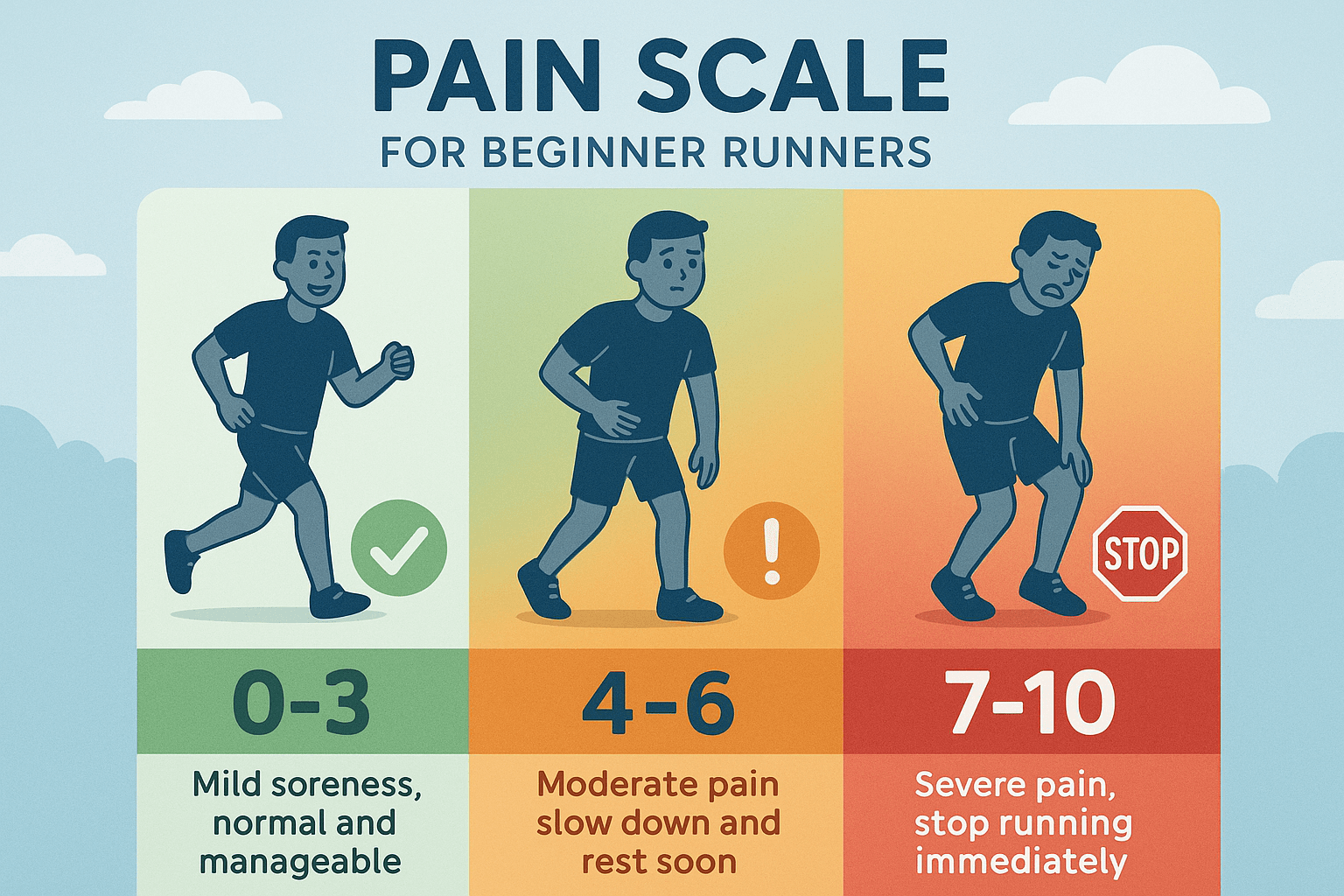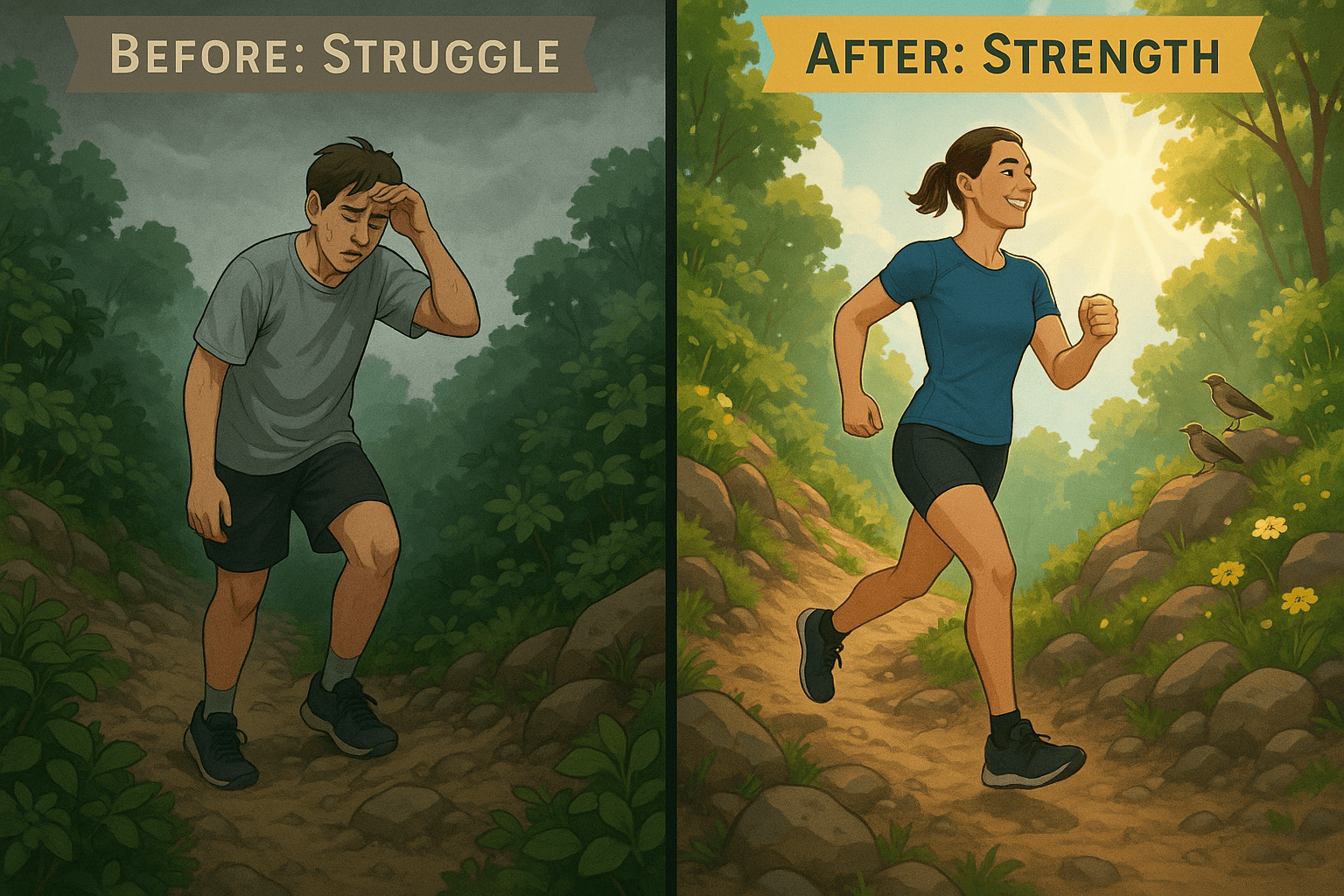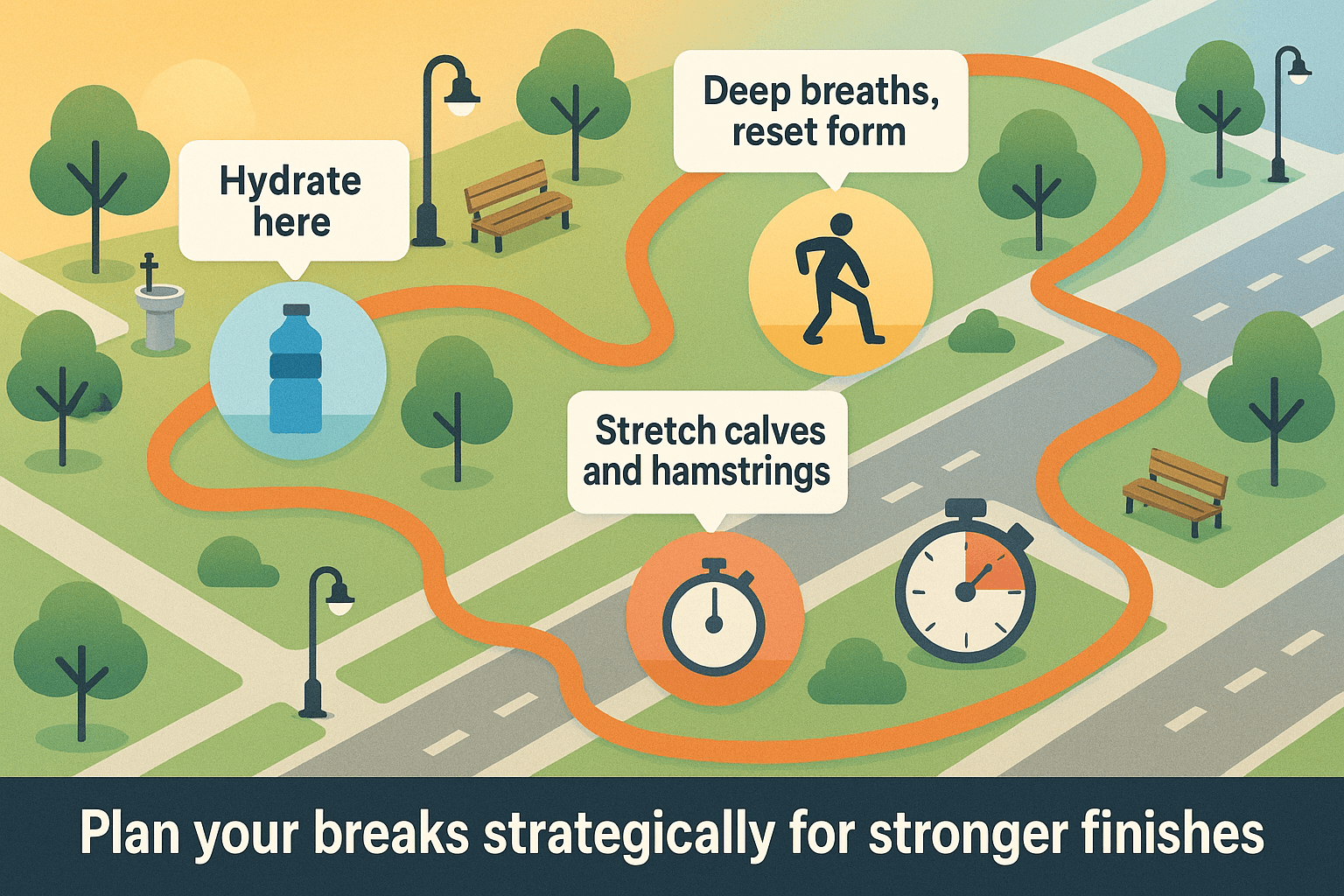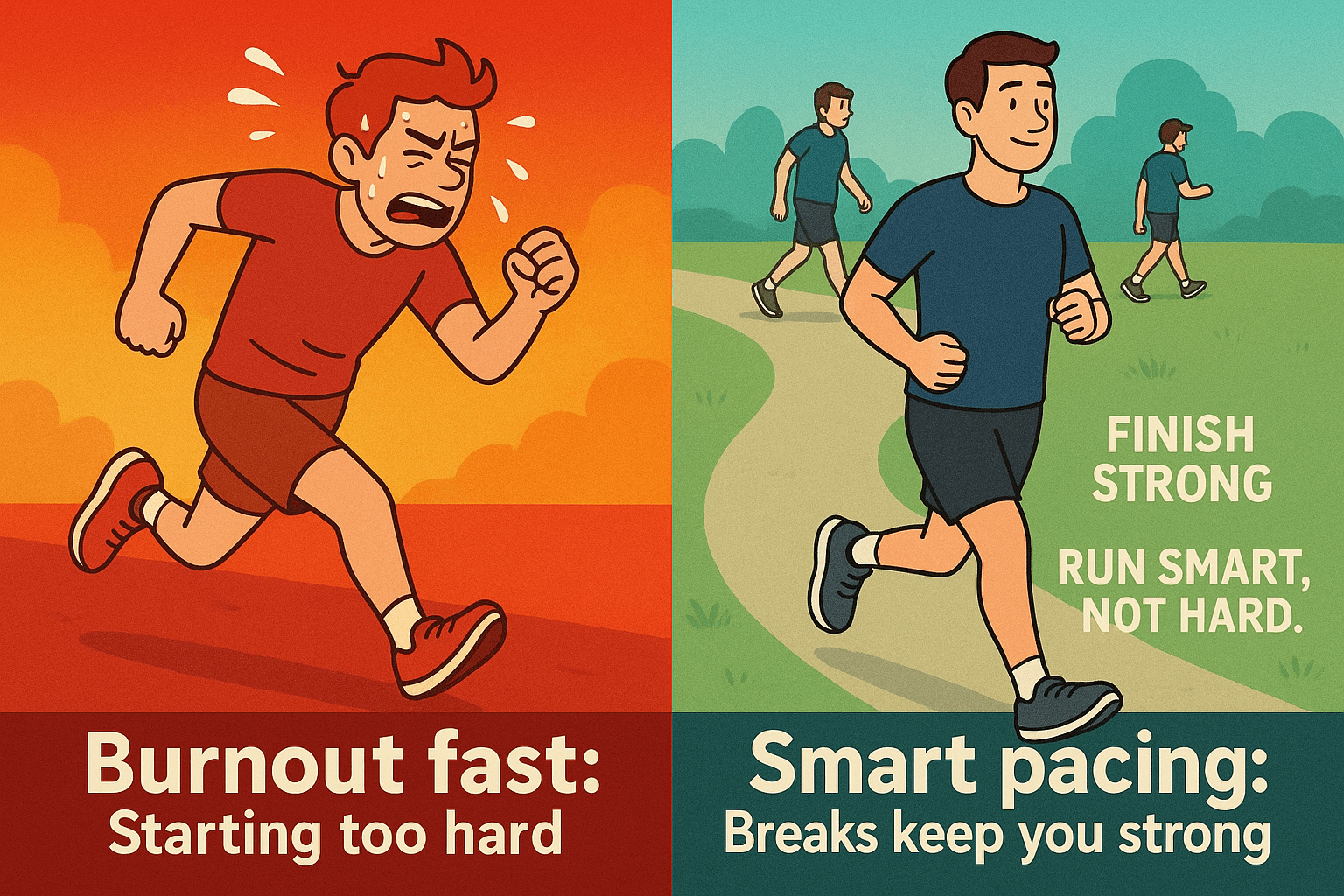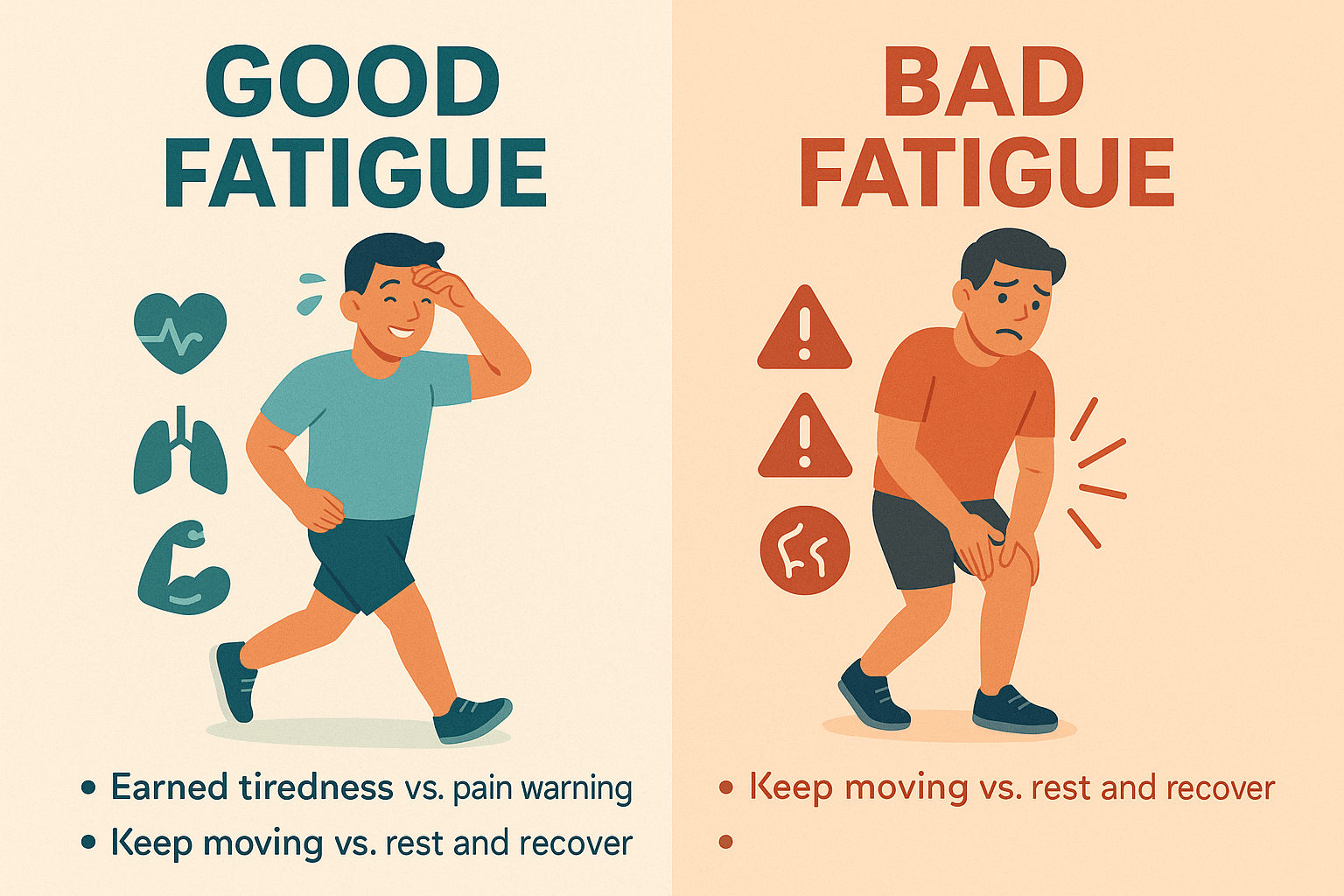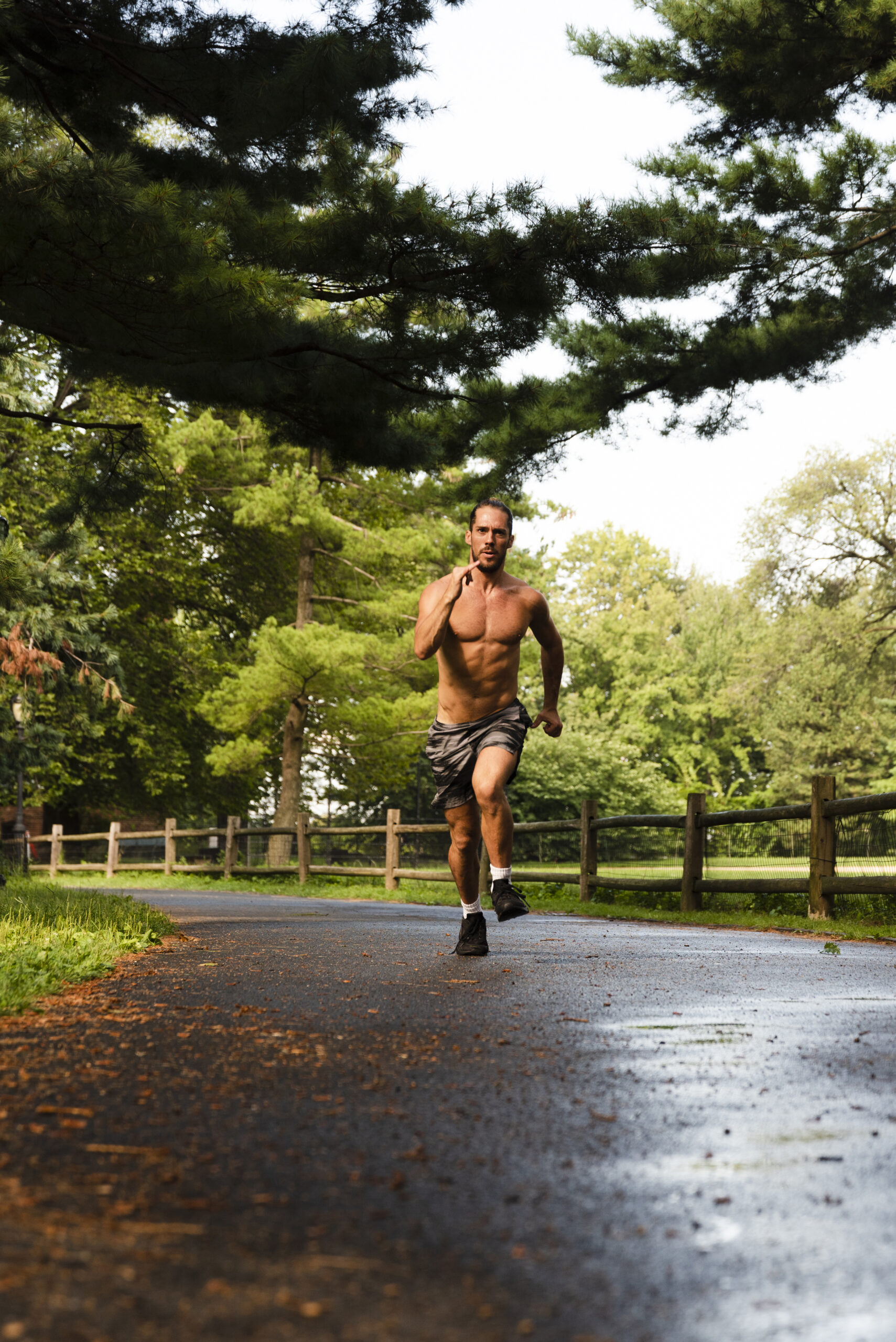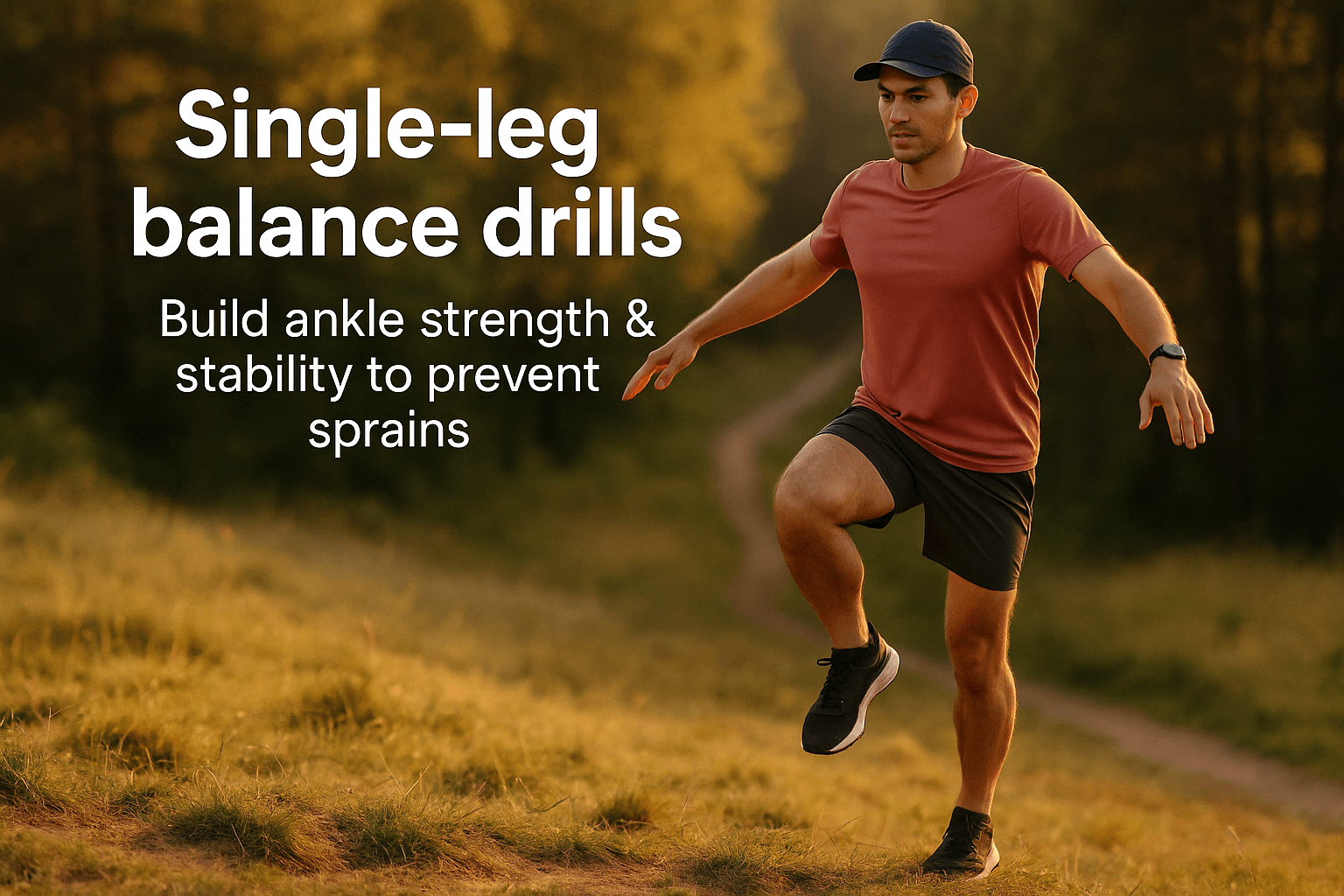If you’re just getting into running and hoping to drop some weight, you’ve probably asked yourself:
“How many calories do I burn running a mile?”
I know I did when I first started pounding the pavement trying to burn off extra fat.
Back then, I heard that running burns “about 100 calories per mile.”
Sounded simple. Multiply your miles by 100, boom—fat gone.
But the truth?
It’s not that neat. Not even close.
Running does burn calories—lots of them—and that’s one reason many of us lace up to slim down.
I used to be one of those “run-to-lose-weight” guys in my early 20s. And yep, it worked.
But what I didn’t know back then—and what I’ve learned through coaching hundreds of runners—is that not everyone burns the same number of calories running a mile.
That 100-calorie rule? It’s just a rough guess.
According to VeryWell Health, your actual calorie burn can swing 20–50% higher or lower, depending on your size, pace, terrain, effort, and more.
Quick Answer:
Most people burn somewhere between 80 and 120 calories per mile.
If you’re on the lighter side or jogging easy, it’ll be closer to 80. If you’re heavier, running fast, or slogging through hills, you might torch 130+.
So yeah, 100 is a good ballpark—but it’s not a magic number.
Here’s what really determines how many calories you burn:
- Your weight
- Your speed and effort
- How fit you are
- The surface you’re running on
- The weather
- Your training style (steady runs vs. intervals)
Let’s break each one down. I’ll mix in real stories from my own running life and coaching experiences to show how this plays out beyond the science.
But before we dive in, one thing I’ve got to say: Don’t obsess over the exact calorie number.
I used to log every single bite and every single run like a madman. And while it helped me get lean at first, it also messed with my mindset.
Running is more than math. It builds your lungs, clears your head, toughens your legs, and sharpens your discipline.
And as for weight loss?
A 5-mile run doesn’t give you a free pass to devour a pizza. (Been there. Didn’t work.)
Want to burn more fat? Train smart. Eat smarter. Sleep. Repeat. Calories matter—but so does consistency, recovery, and not losing your mind over the numbers.
Alright, coach hat on—let’s get into what really affects how many calories you burn.
1. Body Weight: Why Heavier Runners Burn More Calories Per Mile
Let’s keep it real — the number one thing that decides how many calories you burn per mile is your body weight.
More weight = more work. It’s basic physics.
Every step takes more effort when you’re carrying extra pounds, which means you torch more calories. Simple as that.
When I first got into running, I was overweight — like, not just a few pounds. I had some serious fat to lose.
At the time, I didn’t care much about pace or distance. I just wanted to sweat and shed weight. And I did.
But here’s something I didn’t expect: as I got lighter, my runs started burning less per mile.
At 200 pounds, an easy mile left me gasping and probably burned around 140 calories.
After I dropped to 170? That same jog only burned about 100–110.
That’s the trade-off no one talks about: You lose weight, you become more efficient… but you also don’t get that calorie-burn bonus anymore. I won’t lie — part of me missed seeing those big numbers on my fitness tracker.
But hey, progress is progress.
I see the same thing with beginners I coach. When they’re heavier, they actually burn more calories per mile than someone smaller doing the same workout.
I always tell them — don’t hate the struggle. Your body’s working hard, and that work is paying off.
Here’s a quick breakdown to show how weight affects calorie burn per mile (don’t overthink the numbers — they’re ballpark):
- 120 lbs : about 90 calories/mile
- 150 lbs : 100–110 calories/mile (this is where that “average 100-calorie mile” comes from)
- 200 lbs : 140 calories/mile
- 250 lbs : 170+ calories/mile
That’s a difference of 50–80 calories per mile just from body weight. That adds up.
Now, body composition plays a role too. Muscle burns more than fat. So two people who weigh the same can burn slightly different amounts based on muscle mass.
A muscular 150-lb guy might burn a bit more than a 150-lb person with higher body fat.
Men tend to carry more muscle, so they often burn a few extra calories compared to women of the same weight — but let’s be clear: weight matters more than gender here. A 180-lb woman will still burn more per mile than a 130-lb man.
One thing I always remind people: just because your per-mile burn goes down doesn’t mean you’re backsliding. It means you’re getting fitter.
But it also means you might need to adjust your food or add a bit more distance if weight loss is still the goal.
I learned that the hard way when I’d reward every run with a slice of cake… and then wondered why the scale didn’t budge. (Yeah. Rookie mistake.)
2. The Faster You Run, The More You Burn (Yep, Afterburn Is Real)
Let’s break a myth real quick: a mile is a mile, right?
Doesn’t matter if you crawl it or sprint it?
Well… not quite.
Yes, the distance stays the same, but how you cover that mile makes a big difference.
When you run faster—really push the pace—your body has to work way harder. You recruit more muscle, breathe like you’re chasing your last breath, and your heart pounds like a war drum.
It’s less efficient on purpose. That’s the point. You burn more fuel because your body’s going full throttle.
I learned this the hard way.
For years, I was a steady plodder—easy pace, just logging miles. Then one week, a coach buddy dragged me to a track session. 400-meter repeats. I was like, “You want me to sprint?!” But I gave it a shot.
Total game-changer.
I was gasping at the end of each lap. Drenched in sweat. And even after I stopped running, my body didn’t calm down. My heart rate stayed jacked. I kept breathing heavy.
I could feel the engine running under the hood long after I was done. That’s when I discovered the afterburn effect—and why fast running torches more calories than jogging.
What’s the Afterburn Effect?
It’s officially called EPOC—Excess Post-exercise Oxygen Consumption.
Basically, your body keeps burning calories after the workout ends.
Kind of like how a car engine stays hot even after you park it. Your system needs time to cool down, refill oxygen, clear out lactic acid, and rebuild what you just wrecked.
According to the Cleveland Clinic, that “afterburn” can account for an extra 6 to 15% of the calories you burned during the workout.
That might sound small, but it adds up—especially over time.
Just don’t treat it like a free pass to inhale a cheeseburger after every run. It’s a calorie bonus, not a buffet license.
Let’s Talk Numbers
Let’s say you weigh around 150 pounds (68 kg):
- Jog a mile in 12 minutes (around 5 mph)? You’re burning roughly 100 calories.
- Push that same mile in 8 minutes (7.5–8 mph)? That same mile could cost you 140–150 calories instead.
That’s a big difference in a short time.
And I feel it too.
When I run fast—really fast—my breath turns into a wheeze, sweat pours, and everything inside me is screaming. But I also know I’m torching calories at a whole different level.
Some folks argue, “Walking three miles burns the same as running three miles.”
Not quite. Over the same distance, yeah, the difference isn’t massive—walking might burn 60–80, running about 100+—but intensity changes the rules.
The faster you go, the more muscles fire up, your form shifts, you dip into that anaerobic zone—and that’s where the afterburn kicks in.
One Mile All-Out vs. Two Miles Easy?
Here’s the nuance: a fast mile burns more than an easy one. But two easy miles might out-burn one mile all-out, just by duration.
It’s a trade-off. Intensity vs. time.
Want to lose weight? You’ve got options:
- Go hard and short: Fast intervals = big burn + afterburn.
- Go long and steady: More total distance = more cumulative calories.
Best move? Mix both into your weekly routine.
3. Fitness Level & Efficiency: When Getting Fitter Burns Fewer Calories
This one can feel a bit unfair: the fitter you get, the fewer calories you burn doing the same run.
Sounds backwards, right?
You’d think being in great shape would turn you into a calorie-torching machine.
But here’s the twist—your body gets smarter. It figures out how to use less energy for the same job. Like switching from a gas guzzler to a hybrid—suddenly, you’re running more miles on less fuel.
I learned this the hard way. A year into consistent running, I was cruising through my usual 5K loop in the neighborhood without breaking a sweat.
My breathing? Chill. My heart rate? Way lower. That same loop used to leave me wrecked and burned around 400 calories.
Now? Closer to 300. My body wasn’t slacking—it had just leveled up. I had trained it to move efficiently, and that meant less calorie burn per mile.
And I’m not the only one. This is actually backed by science.
According to studies like those published in the Journal of Strength & Conditioning Research, beginners tend to burn more because their form’s a mess, their muscles are weaker, and everything feels like a struggle.
But once your body adapts—better form, stronger legs, a more efficient cardio engine—you stop fighting the run and start gliding through it. That’s good for performance… not so great if you’re banking on burning calories.
Now here’s the kicker: even though you burn fewer calories per mile, you’ll probably run more miles or go faster without even realizing it. That adds up.
I might’ve lost 20% of the calorie burn in a 30-minute run once I got fitter—but I could now cover 50% more ground, or hammer out intervals I couldn’t dream of doing before.
Total weekly burn? Higher.
That’s why it’s so important to mix up your training once progress stalls (and yeah, we’ll dig into that in the training section).
Another factor that messes with this whole equation: age and muscle mass.
As we get older, we naturally lose some muscle, and metabolism tends to slow down. I’ve coached some older runners in their 50s and 60s who were fast. Like, pace-for-pace faster than some 20-year-olds.
But because they were leaner, more efficient, and had been running for decades, a moderate 5-miler barely nudged their heart rate. To get a real calorie burn, they had to crank the intensity or run long.
So, if you’re picking up running later in life—or coming back after a long break—just know your baseline burn might not be the same as it was in your younger days.
That’s not a failure.
It just means you’ve got to be smart with effort, duration, and yes… your diet too (metabolism’s not what it used to be, especially after 40).
Here’s a true story: I hit a nasty weight-loss plateau around month six of running. In the beginning, I was dropping kilos like crazy.
Then? Nothing.
I was still running the same three-mile loop, eating the same meals—but the scale wouldn’t budge.
My body had caught on. It wasn’t burning as much on those easy runs anymore, and it had probably adjusted my appetite too (thanks, biology).
So I made a move. I kept my mileage about the same but added one hill workout and one sprint session each week. I also brought in some light strength work—just enough to spark change.
Within a few weeks, the scale started moving again.
Not because I was doing magic—just because I shocked my body out of its groove. New stress = new results.
The takeaway?
If you’ve been running for a while and the fat loss train has stalled, you’re probably not doing anything wrong.
You’re just fit now. You’ve adapted. So change something. Run longer. Run harder. Lift. Mix it up.
4. Terrain & Surface: Hills, Trails, and Treadmills
If you’ve ever run a steep hill or hit a trail that felt like it was trying to chew up your ankles, you’ve probably thought: “Why does this feel way harder than my usual loop?”
Good news—you’re not imagining it. Your body works overtime on uneven ground, and yes, you’re burning more calories.
Living in Bali, I get a daily reminder of this.
We’ve got everything here—beach sand, jungle trails, and some hills that feel like vertical walls. There’s this one trail I love (and hate)—it climbs a small mountain just outside the city.
The first time I tackled it, I was breathing like I’d just sprinted a 400m… except I was barely moving. My calves and quads were screaming. The whole run was just two miles, but I was toast by the end.
Later, I checked my watch—calories burned per mile? Way higher than normal. No surprise there.
Let’s crunch some simple numbers:
➡️ A 140-lb runner cruising 3 miles on flat pavement? Around 300 calories.
➡️ Same person on a hilly route? Easily 360–450 calories—depends on how mean those hills are.
➡️ Treadmill trick: Add a 5% incline. That alone can boost your burn by 20–25%. A 150-lb runner at a 12-min mile might go from ~100 calories to ~125 per mile. That adds up fast.
5. Does Temperature Actually Change How Many Calories You Burn?
Short answer? Yeah, it does.
But it’s not always straightforward.
Running in Bali heat has taught me one thing: when the air feels like soup and the sun is frying your brain by 7 AM, your body works double time.
I’ve led group runs at sunrise where the humidity wrapped around us like a wet blanket. Even at an easy pace, your heart rate spikes.
Why?
Because your body isn’t just powering your legs—it’s also working hard to keep you cool.
It pumps more blood to the skin, cranks out sweat like a busted faucet, and uses energy to try and cool you down. All of that adds to the calorie burn.
But here’s the thing: heat is tricky.
Sure, it makes your body work harder, but it also wears you down fast.
On really hot days, I’ve had to cut runs short or slow way down. So you might burn more per minute, but the total calories? Depends how long you can actually hold on.
Then there’s the cold.
I’ve done races in icy weather, and while the first 10 minutes feel like breathing razors, once I warm up, it’s golden. Cold weather forces your body to burn a little extra just to stay warm.
Shivering? That’s your body torching calories to make heat.
My quick breakdown:
- Hot Weather: My heart rate shoots up even when I’m going slow. I finish drained. Lots of sweat, lots of fluids lost, and yes—a decent calorie burn. But it’s not easy.
- Humid Weather: Brutal. Sweat doesn’t evaporate, so cooling off is harder. I once did a 2-mile run at 34°C with 90% humidity and nearly passed out. It probably burned more calories than a 4-mile run in cooler weather—but was it worth it?
- Cold Weather: Once I’m warm, I fly. Cool temps are my favorite. You burn a bit more in the first few minutes, and if you’re wearing layers, the added weight can up the effort. Cold also helps recovery sometimes.
6. Steady Runs, HIIT, Long Runs — Which Burns the Most Calories?
Not all runs are created equal when it comes to calorie burn.
Some torch fat fast. Others take their time but keep the burn going longer.
Here’s what I’ve learned:
Steady-State Runs (Endurance Runs):
This is your basic, consistent-pace jog. I used to do 3 miles every morning like clockwork. Good for maintenance, but eventually, my body got so used to it that it stopped being a real challenge.
You can still burn a lot of calories if you run long enough, though. A slow 5-mile run can burn more than a fast 2-mile sprint.
HIIT / Speed Work:
This is the spicy stuff. Sprint, jog, repeat. These workouts are intense, and they’re over quick. But the real magic is in the afterburn.
Ever heard of EPOC?
It’s when your body keeps burning calories after the workout to recover. I’ve finished a 30-minute interval run and ended up burning as much as I would in a full hour of steady jogging. Plus, intervals boost your fitness like crazy.
Long Slow Distance (LSD):
These are your weekend long runs. I remember marathon training and doing 18-milers that burned 1,500+ calories.
It’s about duration here. Even a 90-minute jog can torch 800-1,000 calories depending on your weight and pace.
The catch? You get super hungry after. You have to watch the post-run fridge raids.
Running Frequency & Rest:
I’ve made the mistake of thinking I needed to run every day to lose weight.
It backfired. I got injured, burned out, and ate everything in sight.
Now I tell beginners: start with 3-4 runs a week, space them out, and take your rest seriously. Your body burns calories while it recovers too.
Cross-Training & Strength Work:
Not running, but it counts.
Lifting weights bumps up your metabolism by building muscle.
A solid circuit workout can leave you sore and burning calories for hours. I added two strength days per week and noticed better running and more muscle tone.
Real Examples: Calories Burned Running a Mile
Look, every run hits different.
Terrain changes. Your pace fluctuates.
And let’s be real — our weight, mood, and effort play a huge role.
But here’s a quick breakdown of how many calories you might burn per mile under a few common conditions. These aren’t perfect — your numbers may vary — but they give you a solid sense of what’s going on.
Example 1: Easy Jog on Flat Ground (5 mph / 12-min mile)
Think: Recovery jog or beginner pace on flat pavement.
- 120 lbs: ~90 calories
- 140 lbs: ~100 calories
- 160 lbs: ~115 calories
- 200 lbs: ~140 calories
Coach’s note: When I first got into running, I hovered around the 90-100 cal/mile mark. At that stage, every step felt like a victory.
If you’re heavier, the calorie burn naturally goes up. That’s not a bad thing — it just means your body is working hard to move, and that’s progress.
Example 2: Incline Run (5 mph with 5% incline)
Treadmill incline or hilly outdoor route, same pace but uphill.
- 120 lbs: ~110 calories
- 140 lbs: ~125 calories
- 160 lbs: ~145 calories
- 200 lbs: ~175 calories
Coach’s note: Add incline and your legs will definitely notice. Your heart rate spikes, and the calorie burn shoots up too.
I’ve done plenty of these on Bali’s backroads — it’s a grind, but a satisfying one. Even a short hill adds up.
Example 3: Fast Run on Flat Ground (8 mph / 7:30–8:00 pace)
Hard effort, flat road, no room for slacking.
- 120 lbs: ~130 calories
- 140 lbs: ~150 calories
- 160 lbs: ~170 calories
- 200 lbs: ~200 calories
Coach’s note: This is where the real calorie burn happens. I’ve hit this zone during tempo runs, and trust me — it’s not sustainable for long unless you’ve built a solid base.
But if you’re gunning for max burn and speed? This pace will do it.
Takeaway: The combo of weight, speed, and incline really tells the story.
A lighter runner sprinting up a hill could burn just as much as a heavier runner jogging flat. Stack weight and incline and speed? That mile will cost you — and it’ll feel like it.
Is Running Really the King of Calorie Burn?
Short answer: Yep.
Here’s how running stacks up against other cardio when you’re going all in for about an hour (based on an average-weight adult, ~150–160 lbs):
- Running (6–7 mph): ~600–1000 cal/hr
- Jump rope (fast pace): ~700–1000 cal/hr (if you can keep it up that long!)
- Swimming laps (vigorous): ~700–900 cal/hr
- Rowing machine (hard effort): ~600–800 cal/hr
- Cycling (moderate effort): ~500–700 cal/hr
- Brisk walking (4 mph): ~250–350 cal/hr
- Singles tennis (moderate intensity): ~500–600 cal/hr
Coach’s note: Running holds its ground, especially if you’re not just cruising.
You don’t need to go max effort all the time — but compared to walking or casual biking, running is your calorie-burning beast. That’s why so many folks chasing fat loss lean on it.
Final Thought: It’s Not Just About Calories
Let’s not sugarcoat it — running is one of the most efficient ways to burn calories. But calories aren’t the only reason I lace up.
When I started in my early 20s, sure, I wanted to drop some weight.
But the real rewards? They were never on the scale.
- That post-run peace of mind after a stressful day
- The confidence that came from sticking to the plan
- The clarity I got watching a Bali sunset while running solo
Those are the wins I didn’t expect — and they’re why I keep going.
And if you’re only thinking, “How many miles do I need to burn off this burger?” — pause.
Running isn’t punishment.
It’s freedom. It’s your time. Your space.
Use it to grow stronger, not to cancel out a snack.
Real Talk Recap:
- You don’t burn the same number of calories every mile. That’s a myth.
- Heavier runners burn more per mile — that’s basic physics.
- Speed and incline crank up the effort and the burn.
- Running burns more calories per hour than almost any other cardio.
- But don’t run just to burn calories — run for the joy, the focus, the fire inside you.

